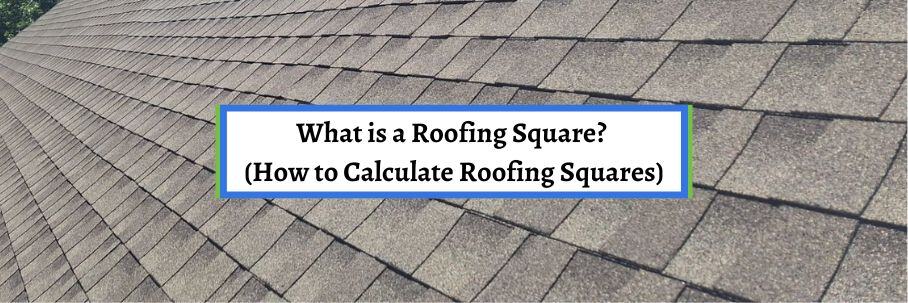Roof Replacement | Roofing Industry Knowledge
What is a Roofing Square? (How to Calculate Roofing Squares)

Do you need a new roof? Are you trying to learn as much as possible about your upcoming investment?
If so, I’m sure you’re seeing the term “square” come up a lot. While it’s standard language in the roofing industry, it’s not something homeowners usually hear until deep into the sales process.
However, it’s a crucial term to understand when determining the budget needed for your future roof replacement and getting estimates.
So, what is a roofing square? How do you determine the number of squares your roof has?
For over 30 years, Bill Ragan Roofing has taken pride in bridging the knowledge gap between roofers and homeowners. So, let’s break down what you need to know about a roofing square.
By the end of this article, you’ll have the answers to the following questions:
- What is a roofing square?
- How do you calculate the number of squares your roof has?
- Can you use your home’s square footage to determine your roof’s square footage?
What is a roofing square?
A roofing square is a 10x10 area of roof surface equal to 100 square feet. For example, 2,000 square feet of roof area is equal to 20 squares.
The number of roof squares has a huge impact on a new roof’s cost, especially the material amount, dump fees, and overall labor costs. However, the type of roofing material you choose determines how much is needed per square.
For example, filling in one roofing square takes about 3 bundles of asphalt shingles (around 22 shingles per bundle, depending on the manufacturer). However, this can vary by shingle type and manufacturer, with some luxury shingles requiring 4 to 6 bundles per square.
How do you calculate the number of squares your roof has?
The only way to get the true number of roof squares is to get an inspection by a professional roofer. However, you can roughly calculate the number of squares your roof has in four steps.
The calculation will not be 100% accurate, but you can use the number to help you get an idea of your new roof’s cost.
Figure out your home’s footprint
First, you need to determine your home’s footprint by multiplying its length and width. To do this, walk the length and width of your home while counting the number of strides you take on each side.
| Length x Width = Home Footprint |
A person of average height has a stride somewhere around 2 to 3 feet, so let’s use 3 feet as our baseline. After counting the strides, multiply the number by 3 to get the length and width of your home.

Finally, multiply the length and width to get your home’s footprint. Remember, it won’t be 100% accurate, but it still gives you a rough measurement.
Add the pitch and complexity multiplier
Next, you need to factor in your roof’s pitch (steepness) and complexity to get the number you’ll multiply the footprint by. Roof pitch and complexity vary from roof to roof, so you need to use your best judgment.
| Pitch and Complexity | Multiplier |
| Up and over, walkable roof | Footprint x 1.3 = Roof’s Square Footage |
| Roof with some complexity and a 5/12 - 8/12 roof pitch | Footprint x 1.4 = Roof’s Square Footage |
| Complex and steep roof (8/12 or steeper) | Footprint x 1.6 = Roof’s Square Footage |
To simplify it, I broke down the multipliers into wide ranges. Once you determine which one to add from the table below, we’re able to get some rough measurements.
Calculate the square footage of your roof
After adding in the multiplier, you’ll first calculate the total square footage of your roof. To get a rough estimate of your roof’s square footage, combine it all into this two-step equation:
| (length of home) x (width of home) = (footprint of your home) |
| (footprint of your home) x (slope and complexity multiplier) = (square feet of roof area) |
Now, let's put these two together and see it in action using the same example as above.

With the total square footage of your roof, you can now determine the total number of squares.
Divide the square footage to get the number of roofing squares
Finally, you get the number of squares by simply dividing the total square footage by 100. After doing this, you’re able to use the number when researching how much a new roof costs.

Just keep in mind that the 22.23 squares in our example will be rounded up to 23 for the material purchase. This ensures that there's enough for your entire roof, reducing the chances of coming up short.
Can you use your home’s square footage to determine your roof’s square footage?
After learning how to calculate a rough number of roofing squares, you may think it’s too much work and a hassle. I get that it’s tempting to use your home’s square footage to bypass figuring out the footprint.
However, your home’s square footage does not equal your roof’s square footage. The numbers may not even be close, which makes an already rough measurement more unreliable.
But why can’t you use your home’s square footage when calculating the number of roofing squares?
Roof Pitch
Roof pitch (also called roof slope) is your roof's steepness (angle). The angle of a roof or roof facet impacts total square footage, which is why it must be factored in with multipliers.
The steeper the roof is, the more the incline increases the total surface area on a facet or the entire roof. This means a roof with a steep pitch has significantly more square footage than a flat roof, even if the separate homes have the same square footage.
Roof Complexity
Roof complexity is how your roof is cut up, such as multiple facets, different pitches, hips, valleys, gables, dormers, and the number of stories off the ground. These architectural features are not included or accounted for in a home's square footage.
The more complexity a roof has, the more roof surface area it has. This is why it’s also included in the multiplier, like roof pitch.
Overhang at the eaves
Eaves are the lower edges of a roof, also considered the gutter line. This creates an overhang that goes beyond your home's exterior walls, which increases a roof’s square footage.
The overhang on the outside will not be accounted for in your home’s interior square footage. Fortunately, it won’t increase a roof’s surface area as much as the other reasons listed here.
Multiple stories
The total number of roofing squares only increases when the total roof surface area increases. As we all know, a roof only covers the upper levels if you have a multi-story home.
So, you can’t use your home’s total square footage when the roof only covers the uppermost level. Even if you have a split-level home, the total roof surface area would be a combination of the roof on each level.
Attics and other unfinished spaces
Attics, garages, and other unfinished spaces aren’t factored into your home’s square footage. However, they still need to be roofed if there isn’t another level above the area.
Attics can also increase a roof’s height and angle, which increases the total roof surface area. If these spaces have a roof directly over them, they won’t be accounted for in your home’s square footage, which would leave a lot of roof area off the calculations.
What else impacts the cost of your new roof?
After reading this article, you know what a roofing square is, how to calculate how many your roof has, and why you can’t use your home’s square footage. Now, you can roughly determine how many roofing squares you have to use when looking up pricing information.
But while the number of roofing squares is a huge cost factor, other factors are just as important. In fact, the only way to truly understand why your roof costs what it does is by knowing what a roofer considers when estimating a roof.
A roof replacement is a huge investment, so it’s crucial for every homeowner to understand what exactly factors into the final cost. That’s why I wrote another article breaking down the 11 factors that impact the cost of your new roof.
Check out the 11 Factors That Impact the Cost of Your New Roof to learn how a roofing contractor comes up with the final number on an estimate.


